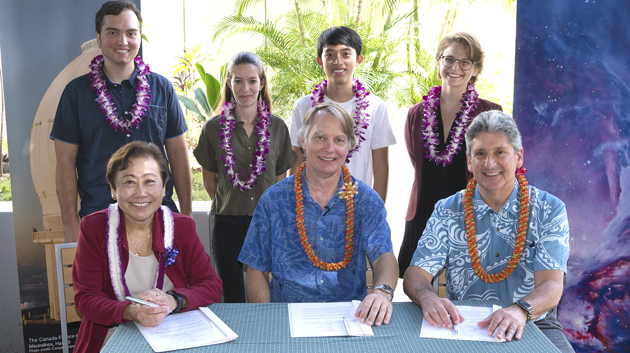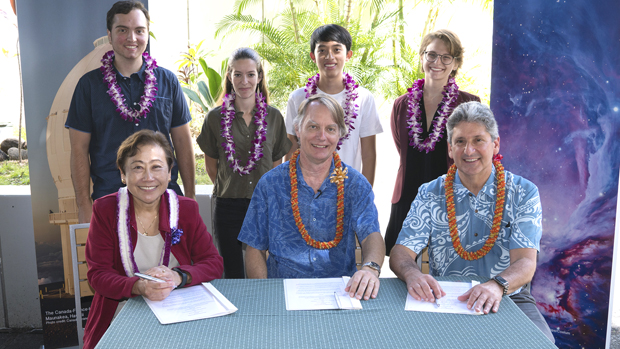
Hawaiʻi’s leading academic institutions formalized an educational partnership designed to bring Hawaiʻi’s high schoolers into one of the world’s most advanced observatory communities. The Maunakea Scholars program helps aspiring astronomers envision their potential of pursuing a career in STEM-related fields. It is the first program of its kind internationally to allocate observing time at major observatories for the direct educational advancement of students.
The collaborative agreement was signed on May 26 by Canada-France-Hawaiʻi Telescope Director Doug Simons, University of Hawaiʻi President David Lassner and Hawaiʻi State Department of Education Superintendent Kathryn Matayoshi at the UH Mānoa Institute for Astronomy.
“The observatories on Maunakea are the best in the world,” said Lassner. “This collaboration will provide some of our own high school students from across the islands with unprecedented opportunities to conduct real research as we work to grow the next generation of world-class astronomers here at home.”
The memorandum will result in the formation of an official working group operating to ensure the program’s continued success and the allocation of its resources. This committee will play a critical role in developing authentic, problem-based learning experiences that aid high school students in their college and career-readiness.
“Students are most successful when they are offered hands-on, innovative opportunities that allow them to be fully immersed in what they are studying,” said Matayoshi. “Maunakea Scholars puts the student in the shoes of the astronomer not just for a day, but a lifetime. It’s truly been an honor to be a part of this endeavor in elevating Hawaiʻi’s schools as leaders in STEM.”
The current cohort of Maunakea Scholars includes five local schools, including Kapolei High School, Kalani High School and Nānākuli High School on Oʻahu, and Waiākea High School and Hawaiʻi Island. Six facilities have committed to the initiative by allocating telescope time for student exploration, including Canada-France-Hawaiʻi Telescope (CFHT), Gemini Observatory, James Clerk Maxwell Telescope, (operated by East Asian Observatory) Las Cumbres Observatory, NASA Infrared Telescope Facility and Subaru Telescope. Programming and education partners also include ʻImiloa Astronomy Center, who are helping develop and provide the cultural educational dimension of the Maunakea Scholars program.
- Related: Maunakea Observatories award Nānākuli and Kapolei students with research time, UH News, February 8, 2017
Maunakea Scholars program to provide more Hawaiʻi students with telescope time, UH Hilo Stories, November 7, 2016
“It has been fascinating and inspirational to see these students formulate ingenious observing proposals,” said Simons. “These students never thought they’d have access to the most powerful telescopes in the world to conduct their own research and it’s remarkable to see the magic that occurs when they are provided with the tools and confidence to make it happen.”

More about the Maunakea Scholars program
To qualify, students in participating schools must conduct astronomical research and assemble a comprehensive proposal that can be conducted at an observatory. Selected proposals are then matched with graduate students from the UH Institute for Astronomy and telescope staff to individually guide them through their research.
Initiated by Canada-France-Hawaiʻi Telescope and Gemini Observatory, and in partnership with the Maunakea Observatories and the Hawaiʻi State Department of Education, Maunakea Scholars successfully launched in 2015 to bring Hawaiʻi’s aspiring young astronomers into the observatory community. This is the first program of its kind internationally, leveraging the most powerful collection of telescopes in the world for the direct educational advancement of Hawaiʻi’s high school students.

